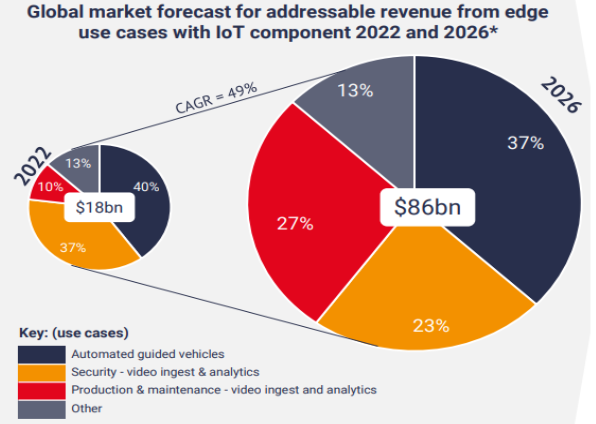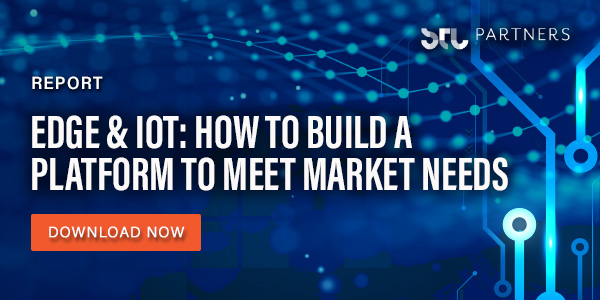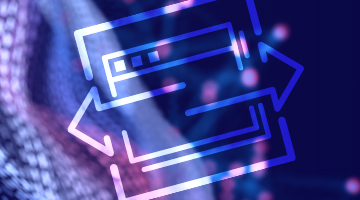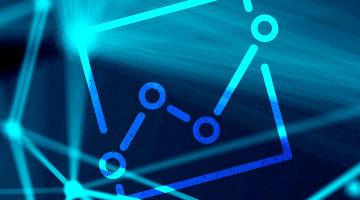The convergence of two powerful technologies — edge computing and the Internet of Things (IoT) — is transforming the way organizations generate, process, manage, and utilize data.
As more and more organizations deploy IoT devices — according to a new report from STL Partners, the market for edge-enhanced IoT use cases will explode from $18 billion in 2020 to $86 billion by 2026 — they need to figure out how to optimize the data these sensors generate.

SOURCE: STL PARTNERS
Since edge computing enables real-time data processing at the source instead of requiring data to be sent to centralized data centers, it’s increasingly obvious that the two technologies are becoming a classic pair.
Move over chips and salsa, peanut butter and jelly, and Batman and Robin; the era of edge and IoT has arrived.
While this synergy is no doubt transformative, it introduces several unique challenges that traditional data platforms — many of which were built for the pre-Internet world — are simply not equipped to address.
Keep reading to learn more about the differences between edge and IoT, some of the challenges organizations face that can be overcome with edge and IoT convergence, key functionality the edge and IoT deliver, and why organizations wishing to unlock the full promise of edge/IoT convergence need a new type of data platform.

Table Of Contents
What’s the difference between edge and IoT platforms?
At a high level, edge computing refers to an architectural approach where applications and data are moved away from the center to the opposite end of the network: the edge. The edge is simply the closest point to data ingestion and the point where data is generated.
By moving workloads to the edge, organizations are able to accelerate data processing while reducing data transmission costs. This translates into several benefits, like reduced latency, greater control and security, and increased application reliability.
IoT platforms are distributed devices and systems that collect and transmit data. Many of us have these in our homes — like smart thermostats that enable us to control heating and cooling and optimize energy usage remotely.
Increasingly, organizations are using IoT devices to optimize warehouse temperature, monitor machine health in real time, track the location of assets, and predict when equipment might need maintenance, among many other use cases.
Why are edge and IoT converging?
According to the STL Partners report, the economy of things (EoT) — a subsector of IoT — will grow 68% annually over the next five years. As the market continues to mature, new use cases will materialize.
In order to maximize these IoT investments, organizations must invest in edge computing infrastructure to reduce backhaul and latency while increasing reliability. In fact, edge is rapidly becoming a necessity for IoT use cases that require real-time, secure environments.
Quite simply, if data generated by an IoT device needs to be transmitted back to a central data center, organizations won’t be able to move at the speed of real time, which prevents them from unlocking the true potential of the technology.
At the same time, when data needs to be sent to a central node for processing, it increases the chances a bad actor can intercept sensitive information. In an age where cyber threats are more and more common — and the average data breach costs $4.45 million — keeping workloads local, at the edge, can help organizations considerably strengthen their security posture.
IoT and edge platforms: Key functions
Historically, IoT platforms have been designed to collect and transmit data. But in recent years, capabilities have grown to include:
- Device lifecycle management, which covers the end-to-end management of IoT devices throughout their useful life, taking care of everything from provisioning to maintenance to decommissioning.
- Device authentication, which ensures that only trusted devices connect to the network, thereby strengthening security with robust access controls.
- Protocol conversion, which enables data exchange to occur between several distinct systems and protocols, something particularly helpful in brownfield environments.
Similarly, edge platforms are built to accommodate use cases with complex requirements, like data security, low latency, and high reliability. The functionality found in these platforms include:
- Edge gateways, which ensure that traffic is routed to the edge, instead of through the cloud, for local processing.
- Edge-to-cloud orchestration, which enables organizations to move workloads between the edge and the cloud.
- Traffic optimization, which routes traffic effectively based on proximity, capacity, network conditions, and workload priority.
When IoT and edge are used in tandem, additional functionality is possible, like:
- Next-level analytics, with the ability to rapidly collect and analyze data right where it’s created instead of transmitting it to a data center first
- Multi-cloud deployments, which enable organizations to access different features from different cloud providers to build the perfect environment for their needs; enterprises can run edge workloads on AWS Outposts, Azure Edge Zone, or an on-prem OpenShift node.
Edge, IoT, and the need for a modern data platform
To make the most out of the edge and IoT, organizations need a modern data platform built for today’s real-time world.
In addition to being able to ingest, analyze, and act on data in actual real time — less than 10 milliseconds — the ideal data platform will also deliver several transformative benefits to enterprises, including:
- Scalability, with the ability to easily accommodate traffic spikes with as many as hundreds of thousands of concurrent users;
- Reduced latency, which allows organizations to take advantage of 5G’s ultra-low latency capabilities;
- Immediate consistency — not eventual consistency — which ensures that data stays up to date and that requests are replicated as fast as possible once they come in;
- Accuracy, which ensures all data is correct, trustworthy, complete, up to date, and free of errors; and
- Resiliency thanks to cross-data center replication (XDCR), which clones data in two directions, from the master to the replica and vice versa, across multiple clusters. This ensures that data is always available even in the event a node or an entire data center fails.
If your goal is maximizing investments in the edge and IoT, relying on a traditional RDBMS simply won’t cut it.
To learn more about why the convergence between edge computing and IoT workloads requires a new type of data platform, check out this recent webinar: Is there such a thing as an edge IoT platform?




